Researchers and students from various centers have also reported advances resulting from working with data:The last days of the year are always a good time to look back and assess the progress made. If a few weeks ago we took stock of what happened in the Aporta initiative, now it is time to compile the news related to data sharing, open data and the technologies linked to them.
Six months ago, we already made a first collection of milestones in the sector. On this occasion, we will summarise some of the innovations, improvements and achievements of the last half of the year.
Regulating and driving artificial intelligence
La inteligencia artificial (IA) continúa siendo uno de los campos donde cada día se aprecian nuevos avances. Se trata de un sector cuyo auge es relativamente nuevo y que necesita regulación. Por ello, la Unión Europea publicó el pasado julio el Reglamento de inteligencia artificial, una norma que marcará el entorno regulatorio europeo y global. Alineada con Europa, España ya presentó unos meses antes su nueva Estrategia de inteligencia artificial 2024, con el fin de establecer un marco para acelerar el desarrollo y expansión de la IA en España.
Artificial intelligence (AI) continues to be one of the fields where new advances are being made every day. This is a relatively new and booming sector in need of regulation. Therefore, last July, the European Union published the Artificial Intelligence Regulation, a standard that will shape the European and global regulatory environment. Aligned with Europe, Spain had already presented its new Artificial Intelligence Strategy 2024 a few months earlier, with the aim of establishing a framework to accelerate the development and expansion of AI in Spain.
On the other hand, in October, Spain took over the co-presidency of the Open Government Partnership. Its roadmap includes promoting innovative ideas, taking advantage of the opportunities offered by open data and artificial intelligence. As part of the position, Spain will host the next OGP World Summit in Vitoria.
Innovative new data-driven tools
Data drives a host of disruptive technological tools that can generate benefits for all citizens. Some of those launched by public bodies in recent months include:
- The Ministry of Transport and Sustainable Mobility has started to use Big Data technology to analyse road traffic and improve investments and road safety.
- The Principality of Asturias announces a plan to use Artificial Intelligence to end traffic jams during the summer, through the development of a digital twin.
- The Government of Aragon presented a new tourism intelligence system, which uses Big Data and AI to improve decision-making in the sector.
- The Region of Murcia has launched “Murcia Business Insight”, a business intelligence application that allows dynamic analysis of data on the region's companies: turnover, employment, location, sector of activity, etc.
- The Granada City Council has used Artificial Intelligence to improve sewerage. The aim is to achieve "more efficient" maintenance planning and execution, with on-site data.
- The Segovia City Council and Visa have signed a collaboration agreement to develop an online tool with real, aggregated and anonymous data on the spending patterns of foreign Visa cardholders in the capital. This initiative will provide relevant information to help tailor strategies to promote international tourism.
Researchers and students from various centers have also reported advances resulting from working with data:
- Researchers from the Center for Genomic Regulation (CRG) in Barcelona, the University of the Basque Country (UPV/EHU), the Donostia International Physics Center (DIPC) and the Fundación Biofísica Bizkaia have trained an algorithm to detect tissue alterations in the early stages and improve cancer diagnosis.
- Researchers from the Spanish National Research Council (CSIC) and KIDO Dynamics have launched a project to extract metadata from mobile antennas to understand the flow of people in natural landscapes. The objective is to identify and monitor the impact of tourism.
- A student at the University of Valladolid (UVa) has designed a project to improve the management and analysis of forest ecosystems in Spain at the local level, by converting municipal boundaries into a linked open data format. The results are available for re-use.
Advances in data spaces
The Ministry for Digital Transformation and the Civil Service and, specifically, the Secretariat of State for Digitalisation and Artificial Intelligence continues to make progress in the implementation of data spaces, through various actions:
- A Plan for the Promotion of Sectoral Data Spaces has been presented to promote secure data sharing.
- The development of Data Spaces for Intelligent Urban Infrastructures (EDINT) has been launched. This project, which will be carried out through the Spanish Federation of Municipalities and Provinces (FEMP), contemplates the creation of a multi-sectoral data space that will bring together all the information collected by local entities.
- In the field of digitalisation, aid has been launched for the digital transformation of strategic productive sectors through the development of technological products and services for data spaces.
Functionalities that bring data closer to reusers
The open data platforms of the various agencies have also introduced new developments, as new datasets, functionalities, strategies or reports:
- The Ministry for Ecological Transition and the Demographic Challenge has launched a new application for viewing the National Air Quality Index (AQI) in real time. It includes health recommendations for the general population and the sensitive population.
- The Andalusian Government has published a "Guide for the design of Public Policy Pilot Studies". It proposes a methodology for designing pilot studies and a system for collecting evidence for decision-making.
- The Government of Catalonia has initiated steps to implement a new data governance model that will improve relations with citizens and companies.
- The Madrid City Council is implementing a new 3D cartography and thermal map. In the Blog IDEE (Spatial Data Infrastructure of Spain) they explain how this 3D model of the capital was created using various data capture technologies.
- The Canary Islands Statistics Institute (ISTAC) has published 6,527 thematic maps with labor indicators on the Canary Islands in its open data catalog.
- Open Data Initiative and the Democratic Union of Pensioners and Retirees of Spain, with support from the Ministry of Social Rights, Consumption and Agenda 2030, presented the first Data website of the Data Observatory x Seniors. Its aim is to facilitate the analysis of healthy ageing in Spain and strategic decision-making. The Barcelona Initiative also launched a challenge to identify 50 datasets related to healthy ageing, a project supported by the Barcelona Provincial Council.
- The Centre for Technological Development and Innovation (CDTI) has presented a dashboard in beta phase with open data in exploitable format.
In addition, work continues to promote the opening up of data from various institutions:
- Asedie and the King Juan Carlos University (Madrid) have launched the Open Data Reuse Observatory to promote the reuse of open data. It already has the commitment of the Madrid City Council and they are looking for more institutions to join their Manifesto.
- The Cabildo of Tenerife and the University of La Laguna have developed a Sustainable Mobility Strategy in the Macizo de Anaga Biosphere Reserve. The aim is to obtain real-time data in order to take measures adapted to demand.
Data competitions and events to encourage the use of open data
Summer was the time chosen by various public bodies to launch competitions for products and/or services based on open data. This is the case of:
- The Community of Madrid held DATAMAD 2024 at the Universidad Rey Juan Carlos de Madrid. The event included a workshop on how to reuse open data and a datathon.
- More than 200 students registered for the I Malackathon, organised by the University of Malaga, a competition that awarded projects that used open data to propose solutions for water resource management.
- The Junta de Castilla y León held the VIII Open Data Competition, whose winners were announced in November.
- The II UniversiData Datathon was also launched. 16 finalists have been selected. The winners will be announced on 13 February 2025.
- The Cabildo of Tenerife also organised its I Open Data Competition: Ideas for reuse. They are currently evaluating the applications received. They will later launch their 2nd Open Data Competition: APP development.
- The Government of Euskadi held its V Open Data Competition. The finalists in both the Applications and Ideas categories are now known.
Also in these months there have been multiple events, which can be seen online, such as:
- The III GeoEuskadi Congress and XVI Iberian Conference on Spatial Data Infrastructures (JIIDE).
- DATAforum Justice 2024.
Other examples of events that were held but are not available online are the III Congress & XIV Conference of R Users, the Novagob 2024 Public Innovation Congress, DATAGRI 2024 or the Data Governance for Local Entities Conference, among others.
These are just a few examples of the activity carried out during the last six months in the Spanish data ecosystem. We encourage you to share other experiences you know of in the comments or via our email address dinamizacion@datos.gob.es.
Data has great power to transform society. Its capacity to generate knowledge, drive innovation and empower citizens is undeniable. In particular, open government data is a resource with which to address major environmental, social and economic challenges from an innovative perspective.
In this sense, public administrations, including the autonomous communities, are organising competitions to promote the data culture. To tell us about these initiatives we have interviewed:
- Sonia Gómez Martín, Head of the Transparency and Information Re-use Service of the Government of Castilla y León.
- Imanol Argüeso Epelde, Head of Projects at the Basque Government's Directorate for Citizen Services and Digital Services.
Listen to the podcast (only available in Spanish)
Summary of the interview
1. To begin with, you can briefly present your data initiatives. What kind of data and contents can we find in the Open Data Euskadi platform? And on the Junta de Castilla y León's Open Data platform?
Imanol Argüeso Epelde: In OpenData Euskadi, the Basque Government's open data initiative, there is a catalogue of around 12,000 datasets from the Basque Government, the three provincial councils of the Autonomous Community of Euskadi - which are Vizcaya, Guipúzcoa and Álava - and the three capitals of these territories. By means of a federation system, all your datasets are displayed in the catalogue.
In addition, there is a community section, where we show news that we consider relevant to the world of open data. We also have a section for competitions and examples of products that have been made with our data.
Sonia Gómez Martín: All of this is similar to what can be found on the Junta de Castilla y León's open data platform. In our case, the open data catalogue only includes data from the Autonomous Community administration itself, not from the different provincial councils or provincial capitals.
In addition to the data catalogue, we have a visualisations portal, where we accommodate data with a large volume of information and where visualisations and API queries can be made. These data are thematic: there are up to 21 categories such as health, public sector, culture, leisure, rural environment and fisheries, and so on.
2. What activities are you carrying out to promote the re-use of this data?
Sonia Gómez Martín: The main activity in recent years has been the organisation and the annual Open Data Competition, through which we encourage reusers to use at least some dataset from our catalogue to create products, services and teaching resources.
There are also a number of other internal activities. For example, courses are run with our training school for internal staff of the Junta, so that they know the importance of reusing information generated within the public sector and making open data available to citizens and businesses.
In addition, there is a news section on the portal and we also receive requests for the dissemination of applications or the opening of data.
Imanol Argüeso Epelde: We also give courses within the Basque Government and to other administrations. For example, this year we have given one to the Provincial Council of Alava. We also have an initiative called Aula Open Data at the University of the Basque Country, located at the School of Engineering in Bilbao. It is a business classroom designed for students to use open data, make applications, visualisations and services derived from the data, and learn about this tool for their future professional activity.
We also participate in any event, conference, talk, etc. When an event related to open data comes up, we usually participate.
3. You have already introduced us to the data contests you organise. Can you tell us a bit more about each of them?
Imanol Argüeso Epelde: In the case of the Basque Country, there are two calls: one for applications and the other for ideas. The registration period for the 5th edition of the two calls is now open, and ends on 10 October.
In the case of the applications competition, any product derived from the open data of any of the catalogues of the Basque Government, provincial councils and the three capitals of the Basque Country will be awarded. It is mandatory to use some dataset from these catalogues. All that is requested is a URL with the service or product to be developed and a short document describing the project.
In the case of the call for ideas, a document explaining an idea for an open data product is needed.
We distributed around €34,000 in prizes in different categories.
It is also important to note that, although it is organised by the Basque Government as such, the three provincial councils and the three town councils of the Basque capitals collaborate: they participate in the jury, help us with promotion, etc.
Sonia Gómez Martín: In our case, it is a single call, but there are four categories. A category of ideas is also established, similar to that of the Basque Government. Another one for products and services that is also similar to the one Imanol mentioned: we are looking for an application or URL where a website is developed that uses some dataset from our catalogue. And then there are two additional categories. One for teaching resources, which seeks to encourage the creation of new and innovative open teaching resources using datasets from our portal to support classroom teaching. And another category of data journalism, which seeks to reward journalistic pieces published or updated in a relevant way in any written or audiovisual medium, where the information takes into account open datasets from our catalogue.
We give away €12,000 in prizes in total. And well, right now we have the 8th edition open until 23 September 2024.
4. What are the requirements for participation?
Sonia Gómez Martín: Entries must not have previously been awarded prizes in other competitions. In all categories it is necessary to use at least one data source from the catalogue of the Junta de Castilla y León's open data portal. And the same person can submit several nominations in different categories.
In the case of data journalism, it is sought to have been published as of the last day on which nominations could be submitted the previous year, which in this case is 3 October 2023.
In the case of the products and services category, there are awards for students, where the applicant must be a student enrolled in the 2023-2024 or 2024-2025 academic year.
Imanol Argüeso Epelde: The case of the Basque Country is similar. It is requested that some dataset from the public open data catalogues we have discussed be used: from the three provincial councils, the three capitals or the Basque Government. In the case of applications, it is also necessary to develop some kind of application, visualisation or website based on this open data.
Both competitions are open to any private individual, professional or even any company.
I would like to take this opportunity to encourage people. The deadline is 10 October and anyone interested still has time to submit an idea or generate a product.
5. And what has been the impact of these competitions? can you give us some examples of solutions, ideas or products that have been submitted to the competition?
Sonia Gómez Martín: There are very interesting things, especially in what the students bring to the table. In the editions in which I have been part of the jury, I have seen, for example, an application, a website, which included the entire offer of vocational training in Castilla y León. Also an analysis of energy data which I found very interesting. In addition, some institutes have submitted and won awards for initiatives based on agricultural information catalogues. They made a small analysis of the peculiarities of our territory.
Imanol Argüeso Epelde: The truth is that most of the products that are generated are not still active. But there are some very interesting examples that still work today. To cite an example, the last edition presented a website called Openslot, which offers information on gaming and recreational machines in the Basque Country: manufacturers, machine models and makes predictions. It is a very sector-specific application.
Another example: last year, a Telegram group that relied on open data to provide information on which time slots are best for energy consumption was the winner and is still active. There are some products that last over time and others that are developed only for competitions.
6. What advice would you give to other public bodies wishing to launch such initiatives?
Imanol Argüeso Epelde: Above all, I would stress the importance of dissemination, of promoting the competitions in training centres, in universities related to information technologies.
It has also worked for us to include a voting system so that people can vote on the nominations. And this year we have included different categories by theme, in the case of ideas. In the case of applications, it is assessed whether access to the data is via an API or the SPARQL point. What we want to do is diversify and make more people eligible for the prize.
Sonia Gómez Martín: I would like to insist on what Imanol said about promotion. It is very important to make universities aware of the competitions and to encourage them to participate. You can also publicise it on social networks, on your portal datos.gob.es, etc. Everything little by little is helping to make them known and to increase the number of participants.
7. These competitions are a window to listen to the needs of re-users, have you taken any concrete action as a result of this feedback?
Sonia Gómez Martín: We have, on the open data portal itself, a section where we receive requests from re-users on what types of open data they would like to have. We receive them and we pass them on, but it is true that internally we sometimes have problems for the data they demand to materialise. It is not always easy for the management centre on which these data depend to convert them into open or even structured data formats.
On social media we also have an account on X, @transparencia, where we also receive requests, evaluate them and study them.
Imanol Argüeso Epelde: Yes, it is true. Normally, open data areas are often mere transmitters and it is sometimes difficult to materialise requests. I think that one of the great advantages of the competitions is that, internally, it is a very interesting source of information to listen to the reusers, to see what problems they have, what tools they use, what characteristics they have... and this allows us to focus our efforts.
Following this source of information, we have opened up certain datasets. The example I mentioned, Openslot, uses data that was not open and that we opened as a result of this participant. We have also developed several REST APIs based on the most demanded data: meteorological data, air quality, water quality, etc
Subscribe to our Soundcloud profile to keep up to date with our podcasts
Interview clips
Clip1. What does the Euskadi open data contest consist of? (only available in Spanish)
Clip 2. What is the Castilla y León open data contest? (only available in Spanish)
It seems like only yesterday that we were finishing eating our grapes and welcoming the new year. However, six months have already passed, during which we have witnessed many new developments in the world, in Spain and also in the open data ecosystem.
Join us as we take a look back at some of the most newsworthy open data events that have taken place in our country so far this year.
New regulations to boost open data and its use
During the first weeks of 2024, some legislative advances were made in Europe, applicable in our country. On 11 January, the Data Act came into force, which aims to democratise access to data, stimulate innovation and ensure fair use across Europe's digital landscape. You can learn more about it in this infographic that reviews the most important aspects.
On the other hand, at the national level, we have seen how open data is gaining prominence and its promotion is increasingly taken into account in sectoral regulations. This is the case of the Sustainable Mobility Bill, which, among other issues, includes the promotion of open data for administrations, infrastructure managers and public and private operators.
This is a trend that we had already seen in the last days of 2023 with the validation of Royal Decree-Law 6/2023, of 19 December, approving urgent measures for the implementation of the Recovery, Transformation and Resilience Plan for the public service of justice, the civil service, local government and patronage. This Royal Decree-Law includes the general principle of data orientation and emphasises the publication of automatically actionable data in open data portals accessible to citizens. The government's Artificial Intelligence Strategy 2024 also includes references to data held by public bodies. Specifically, it establishes that a common governance model will be created for the data and documentary corpus of the General State Administration in such a way as to guarantee the standards of security, quality, interoperability and reuse of all the data available for the training of models.
In relation to governance, we saw another development at the end of 2023 that has been reflected in 2024: the adoption of the Standard Ordinance on Data Governance in the Local Entity, approved by the Spanish Federation of Municipalities and Provinces (FEMP in its Spanish acronym). Over the last few months, various local councils have incorporated and adapted this ordinance to their territory. This is the case of Zaragoza or Fuenlabrada.
News on data platforms
In this time, new platforms or tools have also materialised that make data available to citizens and businesses:
- The Government of Spain has created the National Access Point for Traffic and Mobility which includes data on the facilities with electric vehicle charging points, detailing the type of connector, format, charging mode, etc.
- The National Institute of Statistics (INE in its Spanish acronym) has launched a Panel of Environmental Indicators. With it, it will be possible to quantify compliance with environmental targets, such as the Green Deal. It has also created a specific section for high-value data.
- The Statistical Institute of the Balearic Islands (IBESTAT in its Spanish acronym) has revamped its web portal which has a specific section on open data.
- Open Data Euskadi has published a new API that facilitates the reuse of public procurement data from the Basque administration.
- MUFACE (General mutual society of civil servants of the State) has launched a space with historical and current data on choice of entity, health care, etc.
- Some of the local authorities that have launched new data portals include the Diputation of Málaga and the City Council of Lucena (Cordoba).
- The Museo del Prado has set up a virtual tour which allows you to tour the main collections in 360º. It also offers a selection of 89 works digitised in gigapixel.
- Researchers from the University of Seville have collaborated in the launch of the PEPAdb (Prehistoric Europe's Personal Adornment database), an online and accessible tool with data on elements of personal adornment in recent prehistory.
In addition, agreements have been signed to make further progress in opening up data and boosting re-use, demonstrating the commitment to open and interoperable data.
- The INE, the State Tax Administration Agency (AEAT in its Spanish acronym), the Social Security, the Bank of Spain and the State Public Employment Service (SEPE) have signed a agreement to facilitate joint access to databases for research of public interest.
- The councils of Castelldefels, El Prat de Llobregat and Esparreguera have joined the Municipal Territorial Information System (SITMUN) to share geographic information and have access to a transversal information system.
- The Universidad Rey Juan Carlos and ASEDIE, the Multisectorial Association of Information, have joined forces to create the Open Data Reuse Observatory which is born with the vision of catalysing progress and transparency in the infomediary field, highlighting the importance of the data-driven economy.
Boosting the re-use of data
Both the data published previously and those published as a result of this work allow for the development of products and services that bring valuable information to the public. Some recently created examples include:
- The government has launched a tool to track the implementation and impact of the Recovery, Transformation and Resilience Plan investments.
- Data on the network of ports, airports, railway terminals, roads and railway lines can be easily consulted with the this visualiser of the Ministry of Transport and Sustainable Mobility.
- The Barcelona Open Data Initiative has presented a new version of the portal DadesXViolènciaXDones a tool for analysing the impact of policies against male violence.
- Madrid City Council has shown how it measures the use of the Cuña Verde Park through data analysis and its GovTech programme.
- Furthermore, in the field of data journalism, we find many examples, such as this article from elDiario.es where one can visualise, neighbourhood by neighbourhood, the price of rent and access to housing according to income.
These data combined with artificial intelligence makes it possible to solve and advance social challenges, as the following examples show:
- The wildINTEL project, of the University of Huelva, in collaboration with the state agency Consejo Superior de Investigaciones Científicas (CSIC), aims to monitor wildlife in Europe. It combines citizen science and AI for effective biodiversity data collection and management.
- Experts at the International University of La Rioja have developed AymurAI, a project that promotes judicial transparency and gender equality through artificial intelligence, based on methodologies with a gender perspective and open data.
- Two researchers from Cantabria have created a model that makes it possible to predict climatic variables in real time and in high resolution by means of artificial intelligence.
On the other hand, to boost the re-use of open data, public bodies have launched competitions and initiatives that have facilitated the creation of new products and services. Examples from recent months include:
- The7th Castile and Leon open data competition.
- The University of Zaragoza's Pedro R. Muro-Medrano Awards.
- The València City Council awards for open data and data journalism projects.
New reports and resources linked to open data
Some of the reports on open data and its re-use published in the first half of the year include:
- The "ASEDIE Report: Data Economy in the infomediary field", now in its twelfth edition.
- The ASEDIE report "Geospatial data in the Ministry of Transport and Sustainable Mobility. Impact of the information co-produced by IGN and CNIG".
- The report "The reuse of open data in Spain" by the COTEC Foundation.
- The "Guide of Good Practices for Data Journalists" elaborated by the Observatori de Dades Obertes i Transparència of the Universitat Politècnica de València (UPV).
A large number of events have also been held, some of which can be viewed online and some of which have been chronicled and summarised:
- The "III National Meeting of Open Data (ENDA): Data to boost the tourism sector", organised by the Deputation of Castellón, the Deputation of Barcelona and the Government of Aragón.
- The round table "Building Tourism Intelligence: Data Sharing for Strategic Decisions in the Tourism Sector" organised by SEGITTUR (State Trading Company for the Management of Innovation and Tourism Technologies) as part of Fitur Know-how & Export.
- The session "Managing Water with Open Data" organised within the framework of the CafèAmbDades initiative of the Generalitat de Catalunya.
- The European Data Portal's workshop "How to use open data for your research", with the participation of the Universidad Politécnica de Madrid.
These are just a fe examples that illustrate the great activity that has taken place in the open data environment over the last six months. Do you know of any other examples? Leave us a comment or write to dinamizacion@datos.gob.es!
The promotion of energy efficiency and sustainability is one of the priorities of the European Union and Spain, as reflected in the European Green Pact. The availability of open data related to energy production, distribution and consumption allows governments, businesses and citizens to access essential information to address the challenges of climate change and promote a more sustainable future.
In this post, we explore examples of use cases that show the impact of open data on the energy landscape, as well as sources of interest where to find quality data on the subject.
Open data use cases in the energy sector
EUR 79,600 million. This is the estimated annual savings from open data in the energy sector in the European Union, according to the report "The Economic Impact of Open Data: Opportunities for Value Creation in Europe (2020)". This is possible thanks to multiple projects and applications based on open data that affect various areas.
-
More efficient resource planning
Access to open data on available energy resources makes it possible to identify the most suitable areas to develop projects, ensuring that the use of available natural resources is maximised. For example, in the Baltic Sea, natural gas infrastructure is being expanded to meet the region's growing needs. By taking advantage of Copernicus' advanced data together with its own monitoring and forecasting services (including data on wind, waves, sea water level, currents, sea ice, etc.), the Estonian and Finnish governments were able to carry out more efficient planning for the installation of a new plant.
Likewise, the National Geographic Institute has made available to users a viewer to find out the incidence of the sun and determine the best location for solar panels. Thanks to this viewer, different locations and orientations can be analysed to identify the position that maximises solar energy collection.
-
More responsible and efficient consumption
Open data also includes information on the use and performance of different energies. The Junta de Castilla y León, for example, has a dataHub that collects information from more than 1,500 consumer centres. This dashboard allows the analysis by type of energy (electricity, gas, diesel) and by geographical location (educational centres, health centres, administrative offices, hospitals, etc.). This allows them to compare consumption between the buildings they manage and make efficiency decisions, which has resulted in savings of €2M per year since 2015 on the fixed cost of electricity alone.
The Urban3r viewer allows the visualisation of different indicators on the current state of the building, the energy demand data of residential buildings in their current state and after energy refurbishment, as well as the estimated costs of these interventions, facilitating decision making.
Commercial solutions are also available on the market for this purpose, such as Opower, a tool that uses artificial intelligence to provide personalised information to each customer, identifying and suggesting the replacement of inefficient heating and cooling systems. Another example is uplight, which performs energy efficiency analyses for commercial buildings, utilities and government entities with operational and retrofit recommendations to reduce consumption. These examples highlight the business opportunity in this niche market.
-
Possibility to choose cheaper suppliers
Open data provides detailed information on tariffs and prices of different energy suppliers. This transparency allows consumers to easily compare offers and choose the option that best suits their needs. This is the case of applications for choosing petrol stations, such as Mejorgasolinera.com or Precioil.es, which offer detailed information on the country's petrol stations and allow filtering by brand, location or road and sorted by price and distance. We also find similar solutions for the electricity market, such as Tarifaluzhora.
The National Commission for Markets and Competition (CNMC in Spanish) also has a Energy Offers Comparator (CNMC), which allows you to consult gas and electricity offers.
-
Transparency, accountability and harm minimisation
The publication of open data not only allows citizens and organisations to access detailed information on energy production, distribution and consumption. It also increases transparency in resource management and promotes accountability of energy companies and governments.
To this end, OpenOil was born, which aims to reduce the opacity of the oil industry and thereby increase the accountability of oil companies. It provides an open data framework for natural resource management at the supranational level, as well as consultancy and training services for the creation of natural resource management mechanisms and processes.
In order to minimise the impact of oil spills in the oceans, the Spanish National Research Council (CSIC), in collaboration with Digital Earth Solutions (DES), has developed a unique software, capable of predicting in a few minutes and with great precision the geographic evolution of any oil slick, forecasting its future trajectory in the ocean or studying its movement backwards in time to find its origin.
Where can I find energy data?
If you are thinking of developing such a solution, you are in luck, because there is a wealth of open energy data available on the web.
If you are looking for data from Spain, in addition to datos.gob.es, you can visit the following websites:
- Institute for Energy Diversification and Saving (IDAE). IDAE provides sectorised statistics and energy balances for both primary and final energy, in thousands of tonnes of oil equivalent (ktoe). In total, 69 energy types and 128 energy flows and/or sectors are detailed. The data currently available cover the historical series from 1990 to 2022.
- Red Eléctrica de España. REData is the website of Red eléctrica where we can find national statistical series related to the Spanish electricity system, updated month by month. In this space you can also access information on demand, generation, balancing, exchange, transmission and electricity markets, whose data are available through a REST API. Depending on the nature of the dataset, we can find data that are updated annually, quarterly or even daily. Another useful tool of Red Eléctrica is ESIOS, with updated data on generation, consumption, market, prices, etc.
- National Commission for Markets and Competition (CNMC): The CNMC Data open data portal provides direct access to data and indicators relating to the energy markets overseen by the CNMC: electricity, natural gas and oil products. We can find statistics on market prices, the number of users benefiting from the social bonus or the percentage of renewable energy in the total amount, among other values. Data are updated regularly, on a monthly, quarterly or annual basis.
A wealth of information is also available worldwide:
- European Union. On the EU's energy policy website, we find various data and analyses ranging from oil price developments in individual member states to possible energy market scenarios for 2030 and 2050, among many others. In addition, the European Commission's Directorate-General for Energy produces energy statistical fact sheets every two years, based on data from Eurostat and EU greenhouse gas monitoring. The data is broken down by country, which allows for easy comparisons. Also available is the ENSPRESO database, which focuses on the wind, solar and biomass sectors.
- International Energy Agency (IEA). IEA is an international organisation created in 1974 by the Organisation for Economic Co-operation and Development (OECD) to secure energy supplies. Although some of the datasets offered are paid for, open data can also be found on the website and can be downloaded upon registration.
- Other countries: At the international level, we can find detailed portals by country, such as the US Open Energy Data Initiative (OEDI) or the UK.
These are just a few examples of solutions and data sources that highlight the impact that opening up energy data can have on our environment, both in terms of cost savings and efficiency gains. We invite you to share other open data solutions and portals in comments.
The unstoppable advance of ICTs in cities and rural territories, and the social, economic and cultural context that sustains it, requires skills and competences that position us advantageously in new scenarios and environments of territorial innovation. In this context, the Provincial Council of Badajoz has been able to adapt and anticipate the circumstances, and in 2018 it launched the initiative "Badajoz Es Más - Smart Provincia".
What is "Badajoz Es Más"?
The project "Badajoz Is More" is an initiative carried out by the Provincial Council of Badajoz with the aim of achieving more efficient services, improving the quality of life of its citizens and promoting entrepreneurship and innovation through technology and data governance in a region made up of 135 municipalities. The aim is to digitally transform the territory, favouring the creation of business opportunities, social improvement andsettlement of the population.
Traditionally, "Smart Cities" projects have focused their efforts on cities, renovation of historic centres, etc. However, "Badajoz Es Más" is focused on the transformation of rural areas, smart towns and their citizens, putting the focus on rural challenges such as depopulation of rural municipalities, the digital divide, talent retention or the dispersion of services. The aim is to avoid isolated "silos" and transform these challenges into opportunities by improving information management, through the exploitation of data in a productive and efficient way.
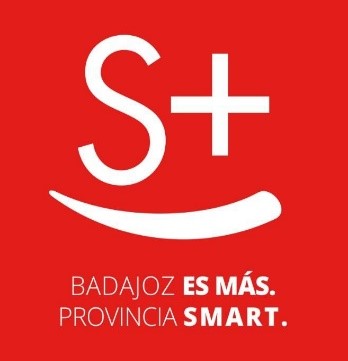
Citizens at the Centre
The "Badajoz es Más" project aims to carry out the digital transformation of the territory by making available to municipalities, companies and citizens the new technologies of IoT, Big Data, Artificial Intelligence, etc. The main lines of the project are set out below.
Provincial Platform for the Intelligent Management of Public Services
It is the core component of the initiative, as it allows for the integration of information from any IoT device, information system or data source in one place for storage, visualisation and in a single place for storage, visualisation and analysis. Specifically, data is collected from a variety of sources: the various sensors of smart solutions deployed in the region, web services and applications, citizen feedback and social networks.
All information is collected on a based on the open source standard FIWARE an initiative promoted by the European Commission that provides the capacity to homogenise data (FIWARE Data Model) and favour its interoperability. Built according to the guidelines set by AENOR (UNE 178104), it has a central module Orion Context Broker (OCB) which allows the entire information life cycleto be managed. In this way, it offers the ability to centrally monitor and manage a scalable set of public services through internal dashboards.
The platform is "multi-entity", i.e. it provides information, knowledge and services to both the Provincial Council itself and its associated Municipalities (also known as "Smart Villages"). The visualisation of the different information exploitation models processed at the different levels of the Platform is carried out on different dashboards, which can provide service to a specific municipality or locality only showing its data and services, or also provide a global view of all the services and data at the level of the Provincial Council of Badajoz.
Some of the information collected on the platform is also made available to third parties through various channels:
- Portal of open dopen data portal. Collected data that can be opened to third parties for reuse is shared through its open data portal. In it we can find information as diverse as real time data on the beaches with blue flags blue flag beaches in the region (air quality, water quality, noise pollution, capacity, etc. are monitored) or traffic flow, which makes it possible to predict traffic jams.
- Portal for citizens Digital Province Badajoz. This portal offers information on the solutions currently implemented in the province and their data in real time in a user-friendly way, with a simple user experience that allows non-technical people to access the projects developed.
The following graph shows the cycle of information, from its collection, through the platform and distribution to the different channels. All this under strong data governance.
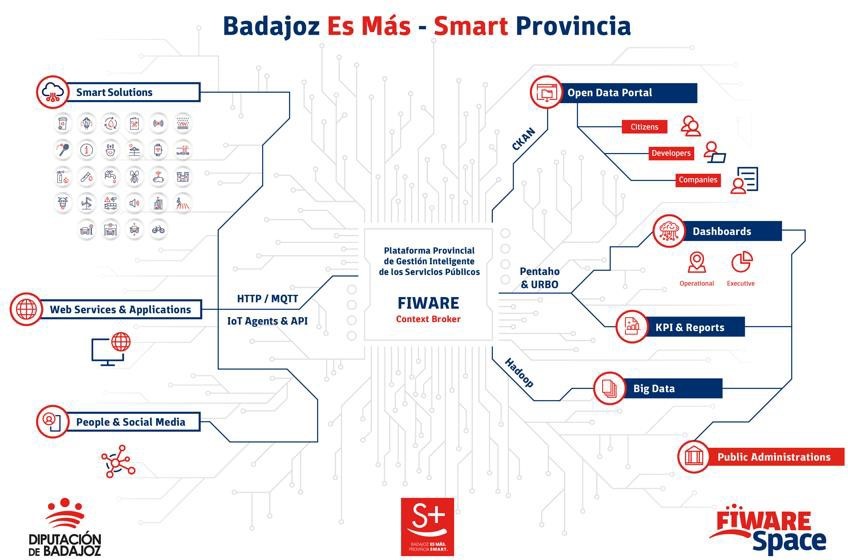
Efficient public services
In addition to the implementation and start-up of the Provincial Platform for the Intelligent Management of Public Services, this project has already integrated various existing services or "verticals" for:
-
To start implementing these new services in the province and to be the example and the "spearhead" of this technological transformation.
- Show the benefits of the implementation of these technologies in order to disseminate and demonstrate them, with the aim of causing sufficient impact so that other local councils and organisations will gradually join the initiative.
There are currently more than 40 companies sending data to the Provincial Platform, more than 60 integrated data sources, more than 800 connected devices, more than 500 transactions per minute... It should be noted that work is underway to ensure that the new calls for tender include a clause so that data from the various works financed with public money can also be sent to the platform.
The idea is to be able to standardise management, so that the solution that has been implemented in one municipality can also be used in another. This not only improves efficiency, but also makes it possible to compare results between municipalities. You can visualise some of the services already implemented in the Province, as well as their Dashboards built from the Provincial Platform at this video.

Innovation Ecosystem
In order for the initiative to reach its target audience, the Provincial Council of Badajoz has developed an innovation ecosystem that serves as a meeting point for the Badajoz Provincial Council:
-
Citizens, who demand these services.
-
Entrepreneurs and educational entities, which have an interest in these technologies.
-
Companies, which have the capacity to implement these solutions.
- Public entities, which can implement this type of project.
The aim is to facilitate and provide the necessary tools, knowledge and advice so that the projects that emerge from this meeting can be carried out.
At the core of this ecosystem is a physical innovation centre called the FIWARE Space. FIWARE Space carries out tasks such as the organisation of events for the dissemination of Smart technologies and concepts among companies and citizens, demonstrative and training workshops, Hackathons with universities and study centres, etc. It also has a Showroom for the exhibition of solutions, organises financially endowed Challenges and is present at national and international congresses.
In addition, they carry out mentoring work for companies and other entities. In total, around 40 companies have been mentored by FIWARE Space, launching their own solutions on several occasions on the FIWARE Market, or proposing the generated data models as standards for the entire global ecosystem. These companies are offered a free service to acquire the necessary knowledge to work in a standardised way, generating uniform data for the rest of the region, and to connect their solutions to the platform, helping and advising them on the challenges that may arise.
One of the keys to FIWARE Space is its open nature, having signed many collaboration agreements and agreements with both local and international entities. For example, work on the standardisation of advanced data models for tourism is ongoing with the Future Cities Institute (Argentina). For those who would like more information, you can follow your centre's activity through its weekly blog.

Next steps: convergence with Data Spaces and Gaia-X
As a result of the collaborative and open nature of the project, the Data Space concept fits perfectly with the philosophy of "Badajoz is More". The Badajoz Provincial Council currently has a multitude of verticals with interesting information for sharing (and future exploitation) of data in a reliable, sovereign and secure way. As a Public Entity, comparing and obtaining other sources of data will greatly enrich the project, providing an external view that is essential for its growth. Gaia-X is the proposal for the creation of a data infrastructure for Europe, and it is the standard towards which the "Badajoz es Más" project is currently converging, as a result of its collaboration with the gaia-X Spain hub.
The energy transition is also a transition of raw materials. When we imagine a sustainable future, we conceive it based on a series of strategic sectors such as renewable energies or electric mobility. Similarly, we imagine a connected and digital future, where new innovations and business models related to the fourth industrial revolution allow us to solve global challenges such as food shortages or access to education. In short, we focus on technologies that help us improve our quality of life.
Why are critical minerals important?
These sectors depend on a series of key technologies, such as energy storage batteries, wind turbines, solar panels, electrolyzers, drones, robots, data transmission networks, electronic devices and space satellites. These are technologies that in recent years have undergone a great technological evolution and an enormous growth in demand worldwide. If we analyze the development forecasts to 2030, we can expect annual growth of at least double digits for many of them, as shown in Figure 1.

Figure 1: Expected growth up to 2030 of some of the key technologies for strategic sectors. Source: McKinsey (image 1, image 2, image 3)
However, as can be seen in Figure 2, many of these future technologies are highly dependent on a set of critical raw materials necessary for their development. Indium and gallium are key to the manufacture of energy-efficient LED lighting, silicon is indispensable for the manufacture of microchips and semiconductors, and the platinum group of metals (such as iridium, palladium, platinum rhodium or ruthenium) are used in catalysts for hydrogen electrolyzers.
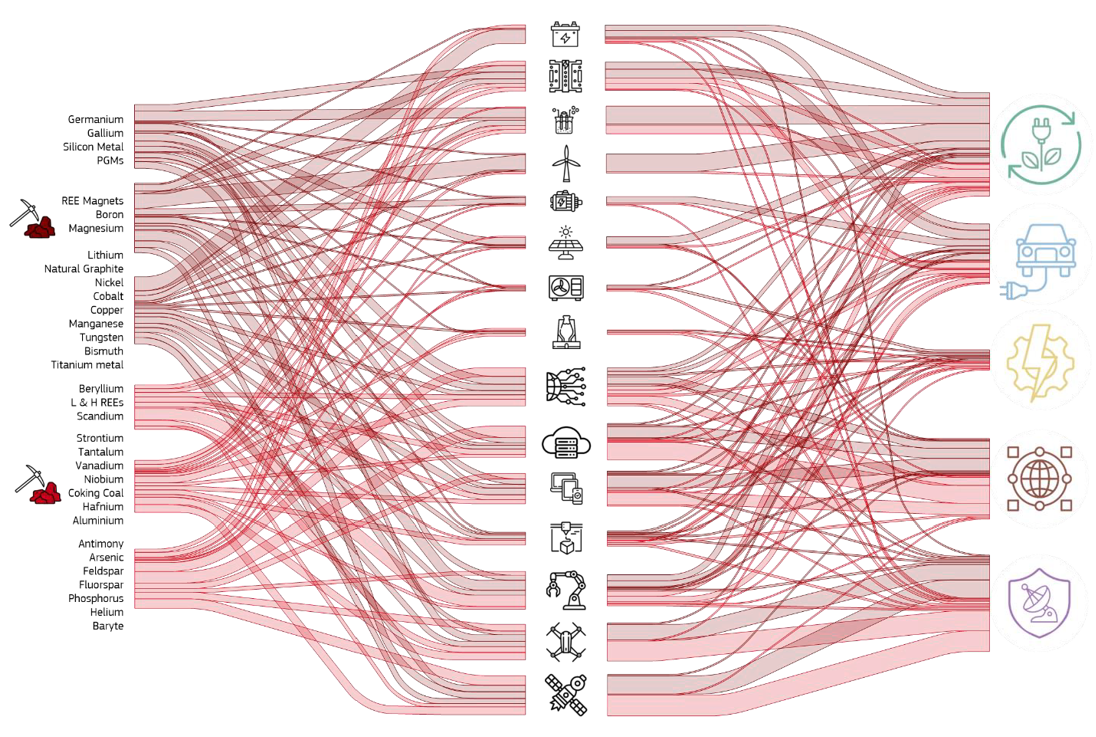
Figure 2: Semi-quantitative representation of raw material flows to the fifteen key technologies and five strategic sectors. Source: JRC Study
So, when does a material become critical? There are several factors that allow us to determine whether a raw material is considered critical:
- Its world reserves are scarce
- There are no alternative materials that can perform their function (their properties are unique or very unique).
- They are indispensable materials for key economic sectors of the future, and/or their supply chain is high-risk.
In the words of Margrethe Vestager, Executive Vice-President of the European Commission, "without a secure and sustainable supply of critical raw materials, there will be no green (sustainable) and industrial transition".
Research into sources of critical minerals data
In order to know in detail the situation of public minerals in Europe, we need to locate quality data. A task for which we will have to look into several sources.
First of all, we go to the European open data portal. From its search engine, in a first iteration, we see that there are more than 46,000 datasets for the query "critical raw materials" (Figure 3).
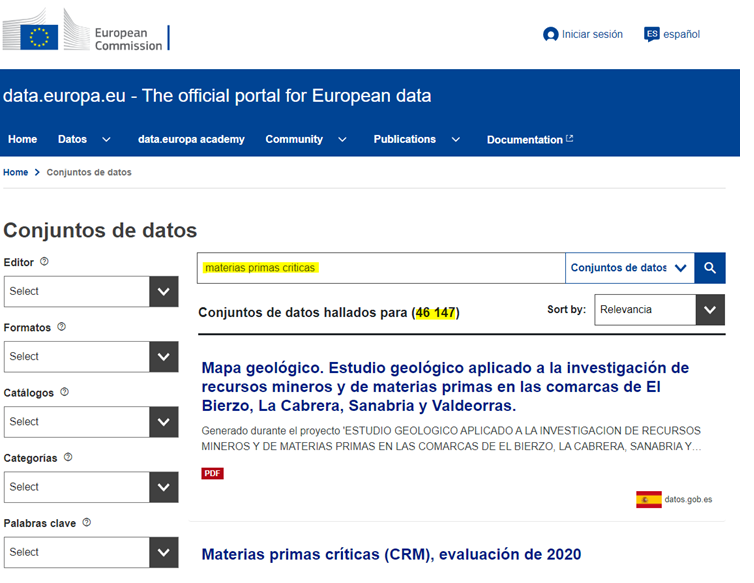
After a first analysis of the available data categories, we adjusted the filters until we narrowed down the datasets of interest to 190 (Figure 4). Particular attention is drawn to the data published by the JRC (European Commission Joint Research Center) and, in particular, to the dataset entitled Critical Raw Materials (CRM), 2020 assessment.
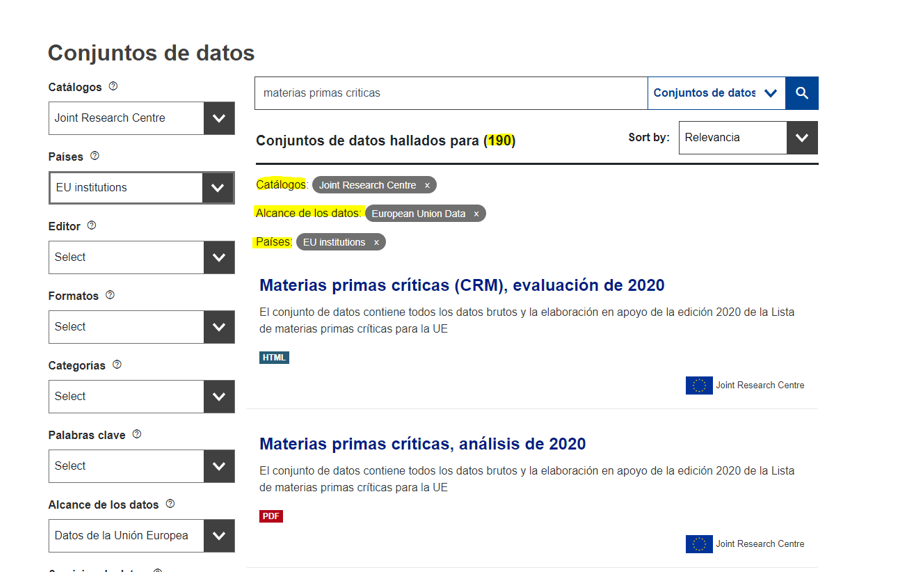
Figure 4: Second search for critical raw materials in the European data portal.
This dataset contains a direct link to a web portal, the RMIS (Raw Material Information System), which is actually the European Commission's reference knowledge base on raw materials through which we can access very relevant data and analysis.
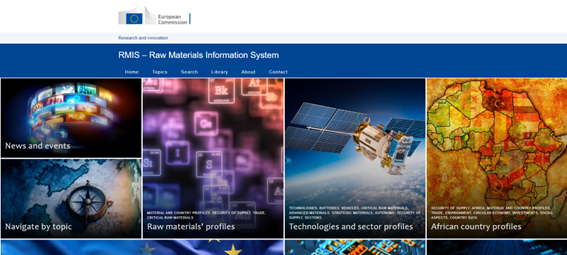
Figure 5: RMIS - European Commission's knowledge base for raw materials
Through the RMIS, we find a very interesting publication for any study on the subject. Although this publication is in PDF format, it allows us to access the list of strategic, critical and non-critical materials identified by the European Commission indicating their level of criticality and their use in different key technologies as shown in Figure 6.

Figure 6: Table of strategic, critical and non-critical raw materials used different key technologies contained in the PDF file. Source: Supply chain analysis and material demand forecast in strategic technologies and sectors in the EU - A foresight study, JRC 2023.
Continuing our exploration, in this case in search of data on mineral reserves in the European continent, we found the European Gelological Data Infrastructure (EDGI) platform, which has an extensive catalog with more than 5,700 datasets and geological services. In our case, after performing a search in its data catalog, we selected three datasets containing interesting information in terms of findings of critical lithium, cobalt and graphite minerals (Figure 7).

Figure 7: Searching for datasets in the EDGI catalog
From the EDGI viewer, we can view the contents of these three datasets before downloading them in GeoJSON format (Figure 8). The three datasets have been originated from the FRAME project (Forecasting And Assessing Europe's Strategic Raw Materials Needs), in which multiple European entities participate, including the Geological and Mining Institute of Spain (IGME).
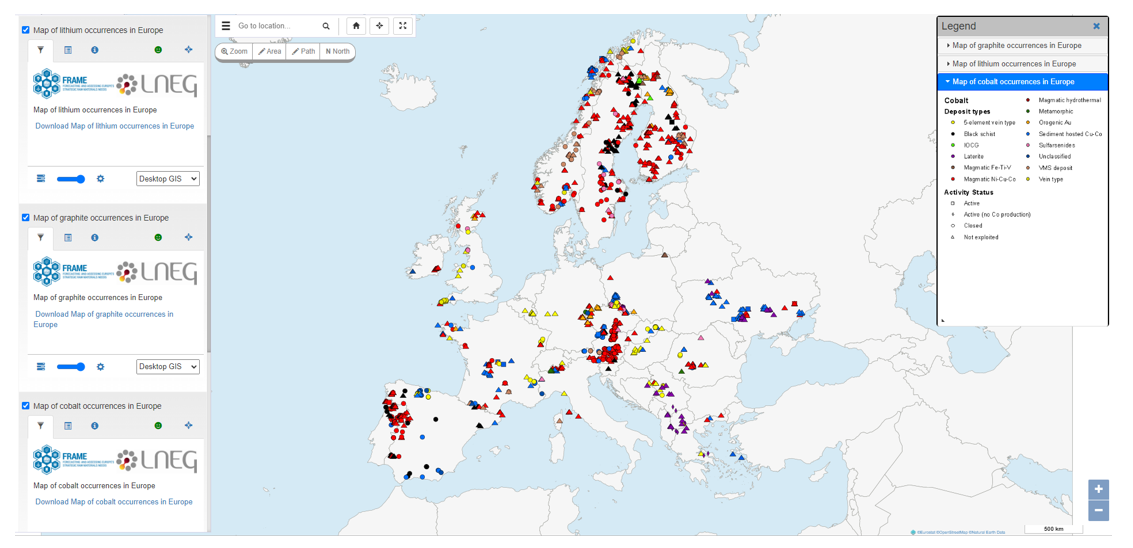
Figure 8: Querying selected datasets through EDGI visualization platform. Source: Map of cobalt occurrences in Europe, Map of graphite occurrences in Europe, Map of lithium occurrences in Europe, FRAME project.
Lastly, we went to the data portal of the International Energy Agency (IEA) (Figure 9). In this case, we found, among its more than 70 datasets, one directly related to our field of research, entitled Critical Minerals Demand Dataset, which we proceeded to download for further analysis in excel format.
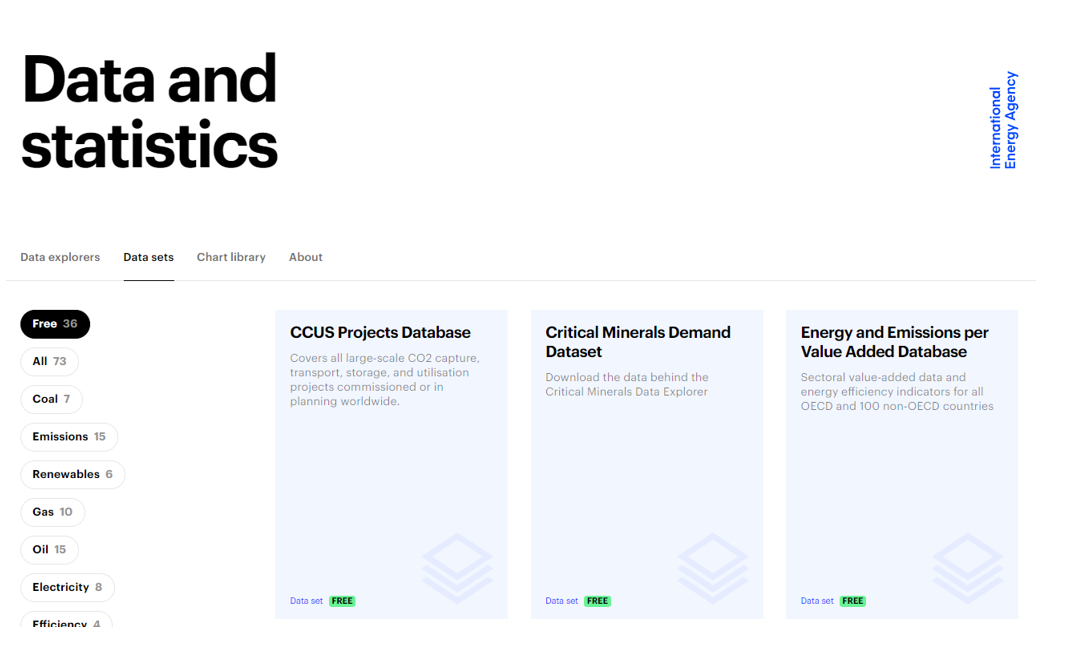
Figure 9: Capture of the International Energy Agency (IEA) data portal.
After this search, we have located some interesting data that can help us to carry out different analyses.
Although this exercise has been carried out under the theme of critical minerals, European open data portals provide a large amount of information and diverse data sets on many areas of interest that can help us understand the challenges we face as a society, from the energy transition to the fight against poverty or food waste. Data that will allow us to carry out analyses aimed at making better decisions to move towards a more prosperous and sustainable future.
Content elaborated by Juan Benavente, industrial engineer and expert in technologies linked to the data economy. The contents and points of view reflected in this publication are the sole responsibility of the author.
The UNESCO (United Nations Educational, Scientific and Cultural Organization) is a United Nations agency whose purpose is to contribute to peace and security in the world through education, science, culture and communication. In order to achieve its objective, this organisation usually establishes guidelines and recommendations such as the one published on 5 July 2023 entitled 'Open data for AI: what now?'
In the aftermath of the COVID-19 pandemic the UNESCO highlights a number of lessons learned:
- Policy frameworks and data governance models must be developed, supported by sufficient infrastructure, human resources and institutional capacities to address open data challenges, in order to be better prepared for pandemics and other global challenges.
- The relationship between open data and AI needs to be further specified, including what characteristics of open data are necessary to make it "AI-Ready".
- A data management, collaboration and sharing policy should be established for research, as well as for government institutions that hold or process health-related data, while ensuring data privacy through anonymisation and anonymisation data privacy should be ensured through anonymisation and anonymisation.
- Government officials who handle data that are or may become relevant to pandemics may need training to recognise the importance of such data, as well as the imperative to share them.
- As much high quality data as possible should be collected and collated. The data needs to come from a variety of credible sources, which, however, must also be ethical, i.e. it must not include data sets with biases and harmful content, and it must be collected only with consent and not in a privacy-invasive manner. In addition, pandemics are often rapidly evolving processes, so continuous updating of data is essential.
- These data characteristics are especially mandatory for improving inadequate AI diagnostic and predictive tools in the future. Efforts are needed to convert the relevant data into a machine-readable format, which implies the preservation of the collected data, i.e. cleaning and labelling.
- A wide range of pandemic-related data should be opened up, adhering to the FAIR principles.
- The target audience for pandemic-related open data includes research and academia, decision-makers in governments, the private sector for the development of relevant products, but also the public, all of whom should be informed about the available data.
- Pandemic-related open data initiatives should be institutionalised rather than ad hoc, and should therefore be put in place for future pandemic preparedness. These initiatives should also be inclusive and bring together different types of data producers and users.
- The beneficial use of pandemic-related data for AI machine learning techniques should also be regulated to prevent misuse for the development of artificial pandemics, i.e. biological weapons, with the help of AI systems.
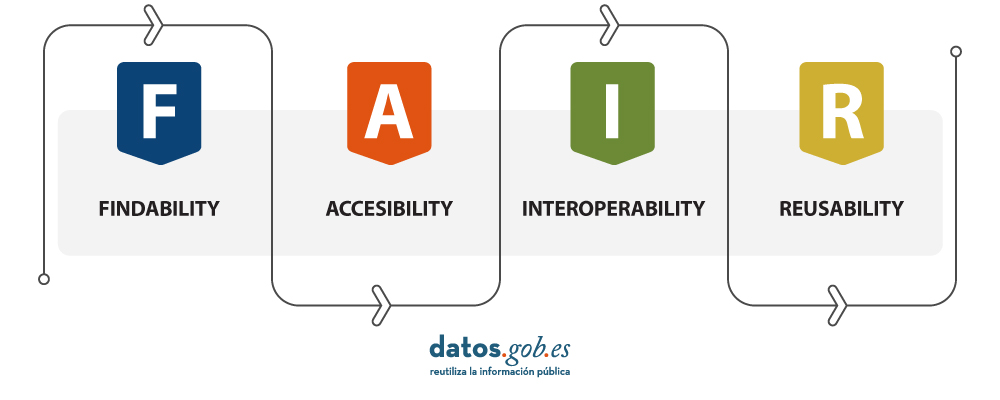
The UNESCO builds on these lessons learned to establish Recommendations on Open Science by facilitating data sharing, improving reproducibility and transparency, promoting data interoperability and standards, supporting data preservation and long-term access.
As we increasingly recognise the role of Artificial Intelligence (AI), the availability and accessibility of data is more crucial than ever, which is why UNESCO is conducting research in the field of AI to provide knowledge and practical solutions to foster digital transformation and build inclusive knowledge societies.
Open data is the main focus of these recommendations, as it is seen as a prerequisite for planning, decision-making and informed interventions. The report therefore argues that Member States must share data and information, ensuring transparency and accountability, as well as opportunities for anyone to make use of the data.
UNESCO provides a guide that aims to raise awareness of the value of open data and specifies concrete steps that Member States can take to open their data. These are practical, but high-level steps on how to open data, based on existing guidelines. Three phases are distinguished: preparation, data opening and follow-up for re-use and sustainability, and four steps are presented for each phase.
It is important to note that several of the steps can be carried out simultaneously, i.e. not necessarily consecutively.
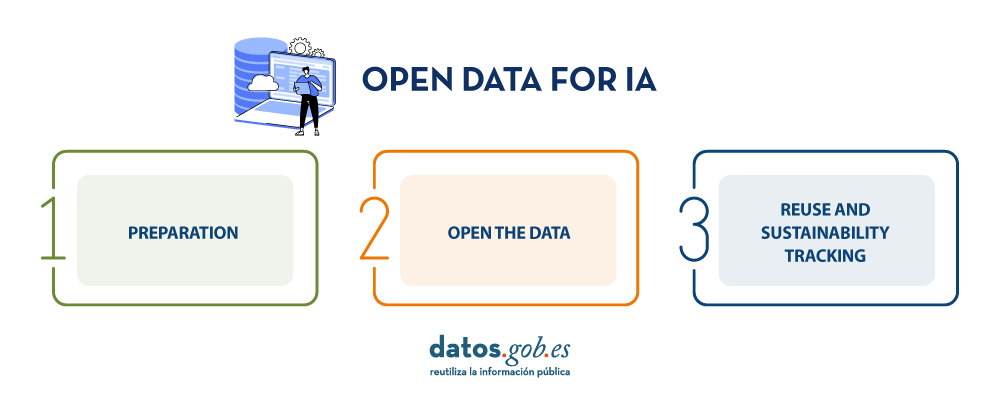
Step 1: Preparation
- Develop a data management and sharing policy: A data management and sharing policy is an important prerequisite for opening up data, as such a policy defines the governments' commitment to share data. The Open Data Institute suggests the following elements of an open data policy:
- A definition of open data, a general statement of principles, an outline of the types of data and references to any relevant legislation, policy or other guidance.
- Governments are encouraged to adhere to the principle "as open as possible, as closed as necessary". If data cannot be opened for legal, privacy or other reasons, e.g. personal or sensitive data, this should be clearly explained.
In addition, governments should also encourage researchers and the private sector in their countries to develop data management and sharing policies that adhere to the same principles.
- Collect and collate high quality data: Existing data should be collected and stored in the same repository, e.g. from various government departments where it may have been stored in silos. Data must be accurate and not out of date. Furthermore, data should be comprehensive and should not, for example, neglect minorities or the informal economy. Data on individuals should be disaggregated where relevant, including by income, sex, age, race, ethnicity, migration status, disability and geographic location.
- Develop open data capabilities: These capacities address two groups:
- For civil servants, it includes understanding the benefits of open data by empowering and enabling the work that comes with open data.
- For potential users, it includes demonstrating the opportunities of open data, such as its re-use, and how to make informed decisions.
- Prepare data for AI: If data is not only to be used by humans, but can also feed AI systems, it must meet a few more criteria to be AI-ready.
- The first step in this regard is to prepare the data in a machine-readable format.
- Some formats are more conducive to readability by artificial intelligence systems than others.
- Data must also be cleaned and labelled, which is often time-consuming and therefore costly.
The success of an AI system depends on the quality of the training data, including its consistency and relevance. The required amount of training data is difficult to know in advance and must be controlled by performance checks. The data should cover all scenarios for which the AI system has been created.
Step 2: Open the data
- Select the datasets to be opened: The first step in opening the data is to decide which datasets are to be opened. The criteria in favour of openness are:
- If there have been previous requests to open these data
- Whether other governments have opened up this data and whether this has led to beneficial uses of the data.
Openness of data must not violate national laws, such as data privacy laws.
- Open the datasets legally: Before opening the datasets, the relevant government has to specify exactly under which conditions, if any, the data can be used. In publishing the data, governments may choose the license that best suits their objectives, such as the creative Commons and Open. To support the licence selection the European Commission makes available JLA - Compatibility Checkera tool that supports this decision
- Open the datasets technically: The most common way to open the data is to publish it in electronic format for download on a website, and APIs must be in place for the consumption of this data, either by the government itself or by a third party.
Data should be presented in a format that allows for localisation, accessibility, interoperability and re-use, thus complying with the FAIR principles.
In addition, the data could also be published in a data archive or repository, which should be, according to the UNESCO Recommendation, supported and maintained by a well-established academic institution, learned society, government agency or other non-profit organisation dedicated to the common good that allows for open access, unrestricted distribution, interoperability and long-term digital archiving and preservation.
- Create a culture driven by open data: Experience has shown that, in addition to legal and technical openness of data, at least two other things need to be achieved to achieve an open data culture:
- Government departments are often not used to sharing data and it has been necessary to create a mindset and educate them to this end.
- Furthermore, data should, if possible, become the exclusive basis for decision-making; in other words, decisions should be based on data.
- In addition, cultural changes are required on the part of all staff involved, encouraging proactive disclosure of data, which can ensure that data is available even before it is requested.
Step 3: Monitoring of re-use and sustainability
- Support citizen participation: Once the data is open, it must be discoverable by potential users. This requires the development of an advocacy strategy, which may include announcing the openness of the data in open data communities and relevant social media channels.
Another important activity is early consultation and engagement with potential users, who, in addition to being informed about open data, should be encouraged to use and re-use it and to stay involved.
- Supporting international engagement: International partnerships would further enhance the benefits of open data, for example through south-south and north-south collaboration. Particularly important are partnerships that support and build capacity for data reuse, whether using AI or not.
- Support beneficial AI participation: Open data offers many opportunities for AI systems. To realise the full potential of data, developers need to be empowered to make use of it and develop AI systems accordingly. At the same time, the abuse of open data for irresponsible and harmful AI applications must be avoided. A best practice is to keep a public record of what data AI systems have used and how they have used it.
- Maintain high quality data: A lot of data quickly becomes obsolete. Therefore, datasets need to be updated on a regular basis. The step "Maintain high quality data" turns this guideline into a loop, as it links to the step "Collect and collate high quality data".
Conclusions
These guidelines serve as a call to action by UNESCO on the ethics of artificial intelligence. Open data is a necessary prerequisite for monitoring and achieving sustainable development monitoring and achieving sustainable development.
Due to the magnitude of the tasks, governments must not only embrace open data, but also create favourable conditions for beneficial AI engagement that creates new insights from open data for evidence-based decision-making.
If UNESCO Member States follow these guidelines and open their data in a sustainable way, build capacity, as well as a culture driven by open data, we can achieve a world where data is not only more ethical, but where applications on this data are more accurate and beneficial to humanity.
References
https://www.unesco.org/en/articles/open-data-ai-what-now
Author : Ziesche, Soenke , ISBN : 978-92-3-100600-5
Content prepared by Mayte Toscano, Senior Consultant in Data Economy Technologies. The contents and points of view reflected in this publication are the sole responsibility of its author.
The humanitarian crisis following the earthquake in Haiti in 2010 was the starting point for a voluntary initiative to create maps to identify the level of damage and vulnerability by areas, and thus to coordinate emergency teams. Since then, the collaborative mapping project known as Hot OSM (OpenStreetMap) has played a key role in crisis situations and natural disasters.
Now, the organisation has evolved into a global network of volunteers who contribute their online mapping skills to help in crisis situations around the world. The initiative is an example of data-driven collaboration to solve societal problems, a theme we explore in this data.gob.es report.
Hot OSM works to accelerate data-driven collaboration with humanitarian and governmental organisations, as well as local communities and volunteers around the world, to provide accurate and detailed maps of areas affected by natural disasters or humanitarian crises. These maps are used to help coordinate emergency response, identify needs and plan for recovery.
In its work, Hot OSM prioritises collaboration and empowerment of local communities. The organisation works to ensure that people living in affected areas have a voice and power in the mapping process. This means that Hot OSM works closely with local communities to ensure that areas important to them are mapped. In this way, the needs of communities are considered when planning emergency response and recovery.
Hot OSM's educational work
In addition to its work in crisis situations, Hot OSM is dedicated to promoting access to free and open geospatial data, and works in collaboration with other organisations to build tools and technologies that enable communities around the world to harness the power of collaborative mapping.
Through its online platform, Hot OSM provides free access to a wide range of tools and resources to help volunteers learn and participate in collaborative mapping. The organisation also offers training for those interested in contributing to its work.
One example of a HOT project is the work the organisation carried out in the context of Ebola in West Africa. In 2014, an Ebola outbreak affected several West African countries, including Sierra Leone, Liberia and Guinea. The lack of accurate and detailed maps in these areas made it difficult to coordinate the emergency response.
In response to this need, HOT initiated a collaborative mapping project involving more than 3,000 volunteers worldwide. Volunteers used online tools to map Ebola-affected areas, including roads, villages and treatment centres.
This mapping allowed humanitarian workers to better coordinate the emergency response, identify high-risk areas and prioritize resource allocation. In addition, the project also helped local communities to better understand the situation and participate in the emergency response.
This case in West Africa is just one example of HOT's work around the world to assist in humanitarian crisis situations. The organisation has worked in a variety of contexts, including earthquakes, floods and armed conflict, and has helped provide accurate and detailed maps for emergency response in each of these contexts.
On the other hand, the platform is also involved in areas where there is no map coverage, such as in many African countries. In these areas, humanitarian aid projects are often very challenging in the early stages, as it is very difficult to quantify what population is living in an area and where they are located. Having the location of these people and showing access routes "puts them on the map" and allows them to gain access to resources.
In this article The evolution of humanitarian mapping within the OpenStreetMap community by Nature, we can see graphically some of the achievements of the platform.
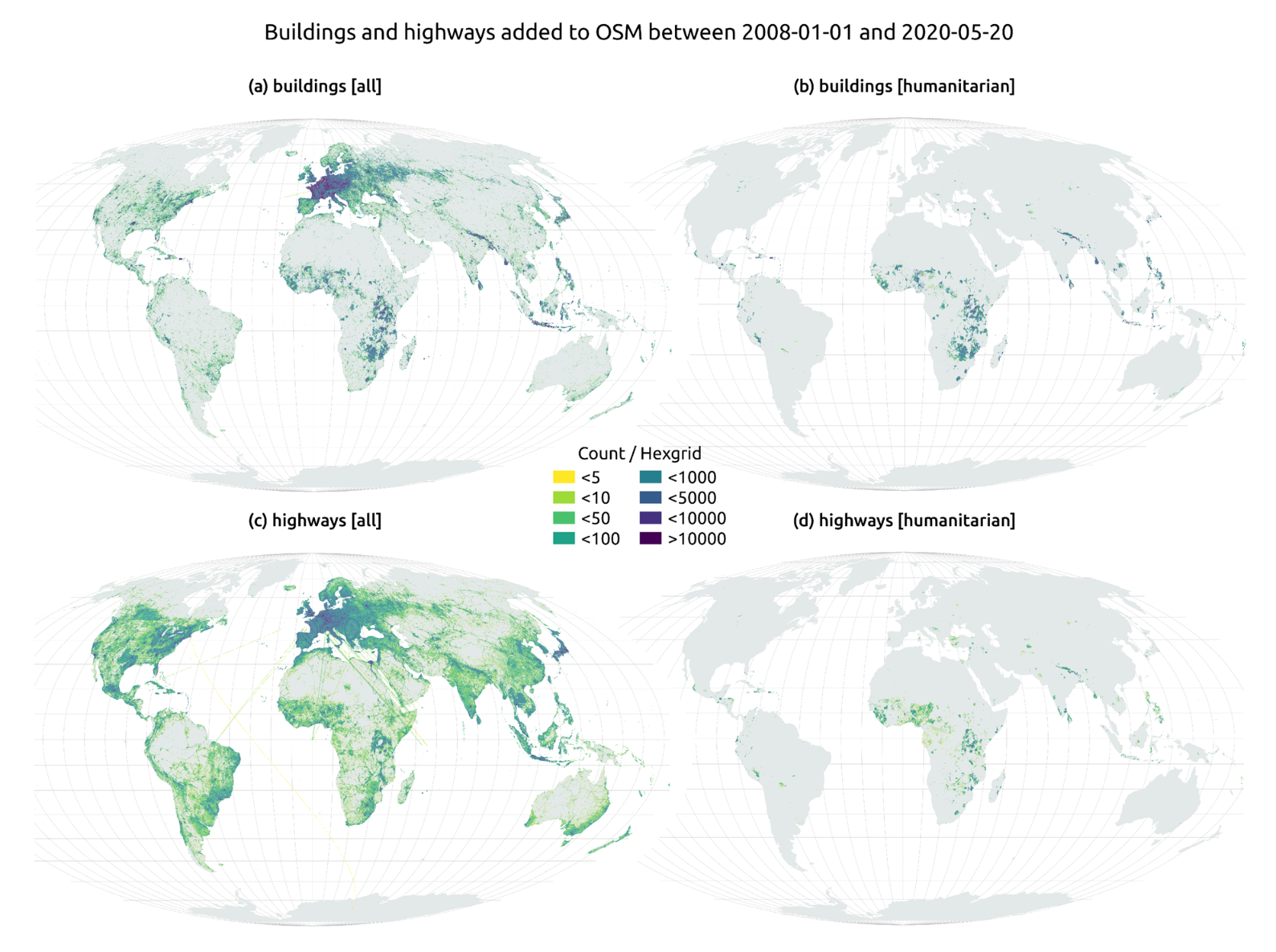
How to collaborate
It is easy to start collaborating with Hot OSM, just go to https://tasks.hotosm.org/explore and see the open projects that need collaboration.
This screen allows us a lot of options when searching for projects, selected by level of difficulty, organisation, location or interests among others.
To participate, simply click on the Register button.
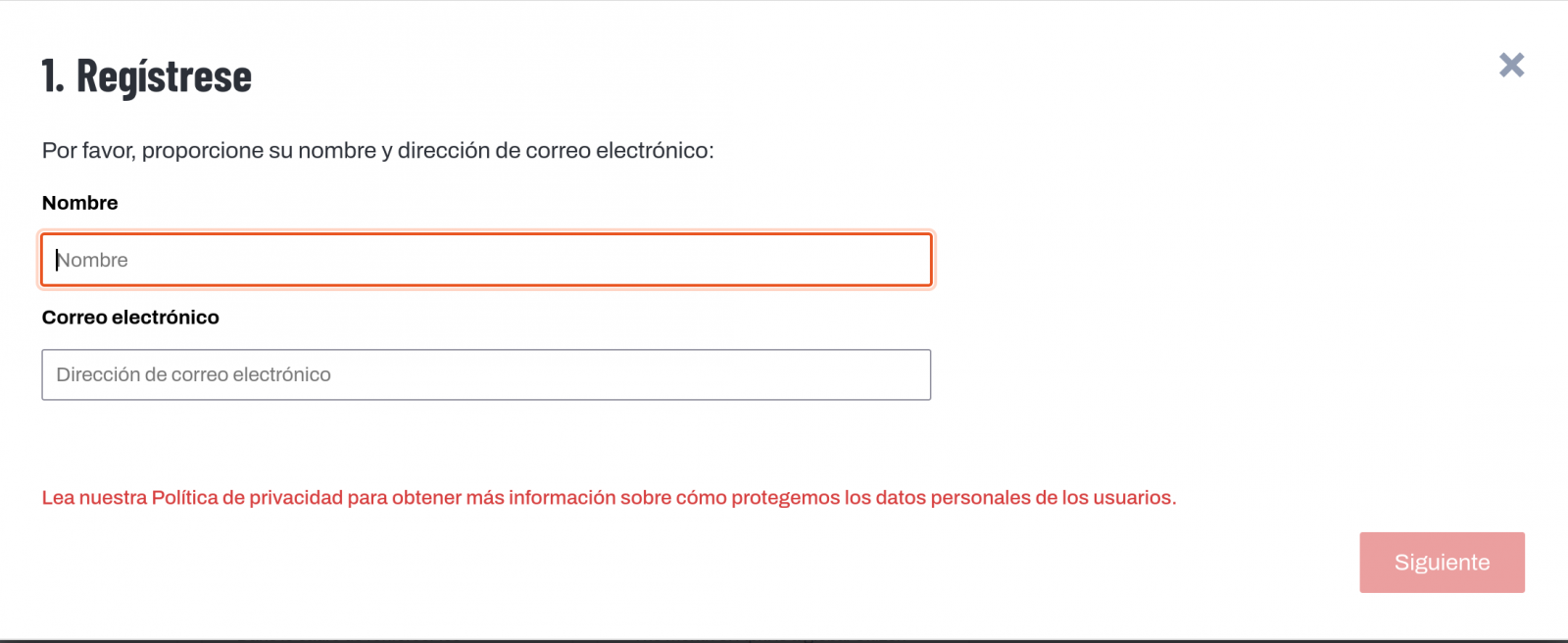
Give a name and an e-mail adress on the next screen:
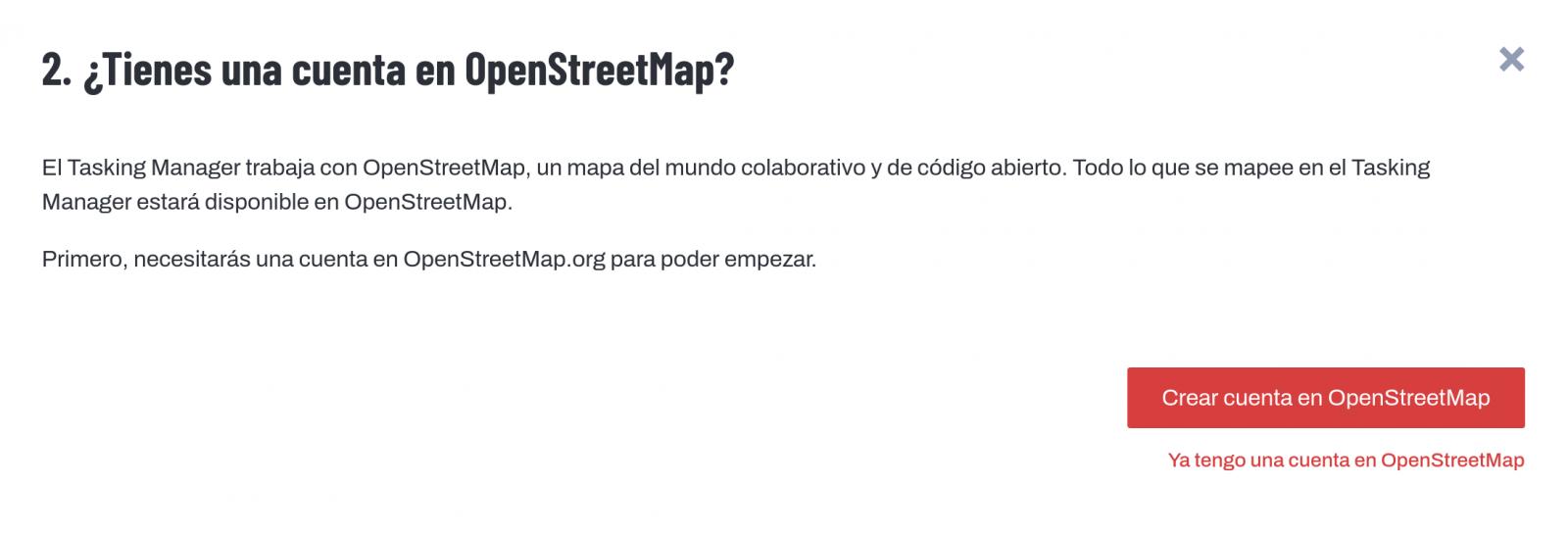
It will ask us if we have already created an account in Open Street Maps or if we want to create one.
If we want to see the process in more detail, this website makes it very easy.
Once the user has been created, on the learning page we find help on how to participate in the project.
It is important to note that the contributions of the volunteers are reviewed and validated and there is a second level of volunteers, the validators, who validate the work of the beginners. During the development of the tool, the HOT team has taken great care to make it a user-friendly application so as not to limit its use to people with computer skills.
In addition, organisations such as the Red Cross and the United Nations regularly organise mapathons to bring together groups of people for specific projects or to teach new volunteers how to use the tool. These meetings serve, above all, to remove the new users' fear of "breaking something" and to allow them to see how their voluntary work serves concrete purposes and helps other people.
Another of the project's great strengths is that it is based on free software and allows for its reuse. In the MissingMaps project's Github repository we can find the code and if we want to create a community based on the software, the Missing Maps organisation facilitates the process and gives visibility to our group.
In short, Hot OSM is a citizen science and data altruism project that contributes to bringing benefits to society through the development of collaborative maps that are very useful in emergency situations. This type of initiative is aligned with the European concept of data governance that seeks to encourage altruism to voluntarily facilitate the use of data for the common good.
Content by Santiago Mota, senior data scientist.
The contents and views reflected in this publication are the sole responsibility of the author.
There are only a few days left until the end of summer and, as with every change of season, it is time to review what the last three months have brought in the Spanish open data ecosystem.
In July we learned of the latest edition of the European Commission's DESI (Digital Economy and Society Index) report, which places Spain ahead of the EU average in digital matters. Our country is in seventh position, improving two places compared to 2021. One of the areas where it performs best is in open data, where it ranks third. These good data are the result of the fact that an increasing number of organisations are committed to opening up the information they hold and more reusers are taking advantage of this data to create valuable products and services, as we will see below.
Advances in strategy and agreements to promote open data
Open data is gaining ground in political strategies at national, regional and local level.
In this regard, in July the Council of Ministers approved the draft Act on the Digital Efficiency of the Public Justice Service, an initiative that seeks to build a more accessible Justice Administration, promoting the data orientation of its systems. Among other issues, this act incorporates the concept of "open data" in the Administration of Justice.
Another example, this time at the regional level, comes from the Generalitat de Valencia, which launched a new Open Data Strategy at the beginning of the summer with the aim of offering quality public information, by design and by default.
We have also witnessed the signing of collaboration agreements to boost the open data ecosystem, for example:
- The Ajuntament de L'Hospitalet and the Universitat Politècnica de Catalunya have signed an agreement to offer training to undergraduate and master's degree students in Big Data and Artificial Intelligence, based on open data work.
- The University of Castilla la Mancha has agreed with the regional government to launch the 'Open Government' chair in order to promote higher education and research in areas such as transparency, open data or access to public information.
- The National Centre for Geographic Information (CNIG) and Asedie have signed a new protocol to improve access to geographic information, in order to promote openness, access and reuse of public sector information.
Examples of data reuse
The summer of 2022 will be remembered for the heat waves and fires that have ravaged different corners of the country. A context in which open data has demonstrated its power to provide information on the state of the situation and help in extinguishing fires. Data from Copernicus or the State Meteorological Agency (AEMET) have been used to monitor the situation and make decisions. These data sources, together with others, are also being used to understand the consequences of low rainfall and high temperatures on European reservoirs. In addition, these data have been used by the media to provide the public with the latest information on the evolution of the fires.
Firefighting based on open data has also been developed at the regional level. For example, the Government of Navarre has launched Agronic, a tool that works with Spatial Data Infrastructures of Navarre to prevent fires caused by harvesters. For its part, the Barcelona Provincial Council's open data portal has published datasets with "essential information" for the prevention of forest fires. These include the network of water points, low combustibility strips and forest management actions, used by public bodies to draw up plans to deal with fire.
Other examples of the use of open data that we have seen during this period are:
- The Environmental Radiological Surveillance Network of the Generalitat de Catalunya has developed, from open data, a system to monitor the radiation present in the environment of the nuclear power plants (Vandellòs and Ascó) and the rest of the Catalan territory.
- Thanks to the open data shared by Aragón Open Data, a new scientific article on Covid-19 has been written with the aim of finding out and identifying spatio-temporal patterns in relation to the incidence of the virus and the organisation of health resources.
- The Barcelona Open Data initiative has launched #DataBretxaWomen, a project that seeks to raise public awareness of the existing inequality between men and women in different sectors.
- Maldito dato has used open data from the statistics developed by the National Statistics Institute (INE) based on mobile positioning data to show how the population density of different Spanish municipalities changes during July and August.
- Within its Data Analytics for Research and Innovation in Health Programme, Catalonia has prioritised 8 proposals for research based on data analysis. These include studies on migraines, psychosis and heart disease.
Developments in open data platforms
Summer has also been the time chosen by different organisations to launch or update their open data platforms. Examples include:
- The Statistical Institute of Navarre launched a new web portal, with more dynamic and attractive visualisations. In the process of creation, they have managed to automate statistical production and integrate all the data in a single environment.
- Zaragoza City Council has also just published a new open data portal that offers all municipal information in a clearer and more concise way. This new portal has been agreed with other city councils as part of the 'Open Cities' project.
- Another city that already has an open data portal is Cadiz. Its City Council has launched a platform that will allow the people of Cadiz to know, access, reuse and redistribute the open data present in the city.
- The Valencian Institute of Business Competitiveness (IVACE) presented an open data portal with all the records of energy certification of buildings in the Valencian Community since 2011. This will allow, among other actions, to carry out consumption analysis and establish rehabilitation strategies.
- Aragón Open Data has included a new functionality in its API that allows users to obtain geographic data in GeoJSON format.
- The National Geographic Institute announced a new version of the earthquake app, with new features, educational content and information.
- The Ministry for Ecological Transition and the Demographic Challenge presented SIDAMUN, a platform that facilitates access to territorial statistical information based on municipal data.
- The open data portal of the Government of the Canary Islands launched a new search engine that makes it possible to locate the pages of the portal using metadata, and which allows exporting in CVS, ODS or PDF.
Some organisations have taken advantage of the summer to announce new developments that will see the light of day in the coming months, such as the Xunta de Galicia, which is making progress in the development of a Public Health Observatory through an open data platform, Burgos City Council, which will launch an open data portal, and the Pontevedra Provincial Council, which will soon launch a real-time budget viewer.
Actions to promote open data
In June we met the finalists of the IV Aporta Challenge: "The value of data for the health and well-being of citizens", the final of which will be held in October. In addition, some competitions have been launched in recent months to promote the reuse of open data, for which the registration period is still open, such as the Castilla y León competition or the first UniversiData Datathon. The Euskadi open data competition was also launched and is currently in the evaluation phase.
With regard to events, the summer started with the celebration of the Open Government Week, which brought together various activities, some of them focused on data. If you missed it, some organisations have made materials available to citizens. For example, you can watch the video of the colloquium "Open data with a gender perspective: yes or yes" promoted by the Government of the Canary Islands or access the webinar presentations to learn about the Data Office and the Aporta Initiative.
Other events that have been held with the participation of the Data Office and whose videos are public are: the National Congress on Archives and Electronic Documents and the Data Spaces as ecosystems for entities to reach further.
Finally, in the field of training, some examples of courses that have been launched these months are:
- The National Geographic Institute has launched an Inter-administrative Training Plan, with the aim of generating a common culture among all the experts in Geographic Information of the public bodies.
- Andalucía Vuela has launched a series of free training courses aimed at citizens interested in data or artificial intelligence.
International News
The summer has also brought many new developments at the international level. Some examples are:
- The beginning of the meteorological summer saw the publication of the results of the first edition of the Global Data Barometer, which measures the state of data with respect to societal issues such as Covid19 or climate.
- The 12 finalists of the Eu Datathon 2022 were also announced.
- An interactive edition of Eurostat's regional yearbook 2021 was published.
- England has developed a strategy to harness the potential of data in health and healthcare in a secure, reliable and transparent way.
This is just a selection of news among all the developments in the open data ecosystem over the last three months. If you would like to make a contribution, feel free to leave us a message in the comments or write to dinamizacion@datos.gob.es.
The number of public institutions and local governments that continue to commit to implementing initiatives aimed at bringing open information closer to the public is growing all the time. If a few months ago we shared the work of Gipuzkoa Irekia or Open Data BizKaia, now it is the turn of the Provincial Council of Castellón, which has just presented a new open data portal.
How has the open data portal changed?
Son muchas las actividades en materia de datos abiertos que llevan a cabo desde la Diputación de Castellón en general, y su servicio de Servicio de Administración e Innovación Pública, en particular, pero en todas ellas el foco está puesto, básicamente, en la difusión, en el conocimiento y la reutilización de la información procedente de los datos abiertos.
There are many open data activities carried out by the Castellón Provincial Council in general, and its Public Administration and Innovation Service in particular, but in all of them the focus is basically on the dissemination, knowledge and reuse of information from open data.
Thus, on the one hand, an open data strategy has been drawn up with the aim of marking the way forward and, on the other, a council of re-users is working with the aim of advising the staff in charge of the governance of the portal, to identify and develop specific content that can be published openly.
Continuing with the idea of improving the open data strategy and bringing it closer to companies and users, the Castellón Provincial Council has completed the process of redesigning its portal, two years after its implementation. The portal maintains its technical and data governance functionalities, but includes important new features in terms of its image and themes.
Design of the new cover
Of all the visual changes recently implemented, perhaps the most significant has been the redesign of the new homepage. It has opted to offer a more visual orientation, which seeks, on the one hand, to highlight a series of data stories, created by combining the most consulted datasets on the portal, and on the other, to highlight the data relating to the fight against depopulation.
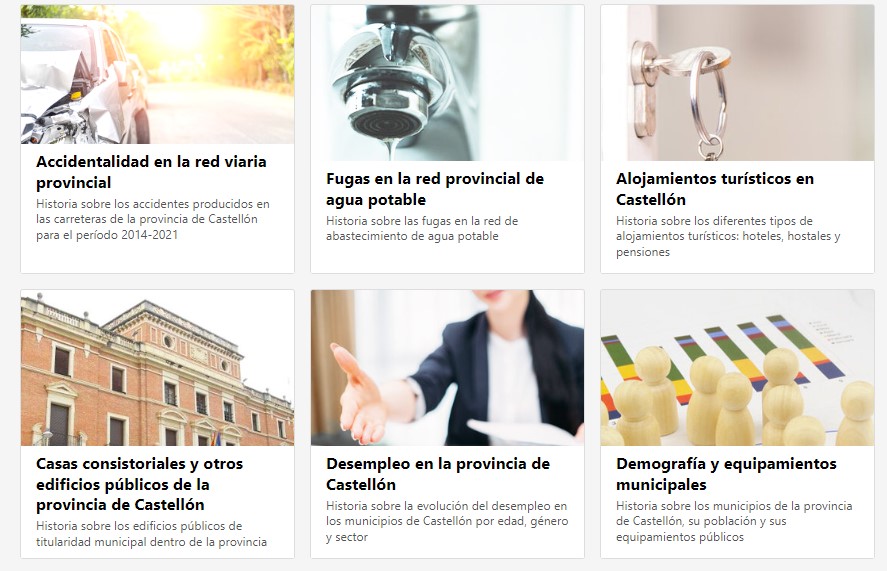
The dashboards or visualisations incorporated into the new front page are a great help for better monitoring and analysing information on key datasets.
Dataset and user statistics
The Castellón Provincial Council's data catalogue currently consists of 96 datasets that are classified in 17 thematic areas of the NTI-RISP. In addition, it should be noted that 49 of these datasets contain geographic information.
The most popular datasets are:
- Urban planning
- Demography
- Mayors of the province
In numerical terms, the urban planning dataset totals 1200 downloads and 33 thousand API calls. In terms of users, the estimated number of unique users who interacted with the domain last April reached 1,000.
Data against depopulation
Another important new feature of the new open data portal is the section dedicated to the depopulation of the territory, which includes all the datasets related to the services provided to the rural world to combat depopulation.
At present, this section is made up of six datasets with information related or linked to the towns in the interior of the province.
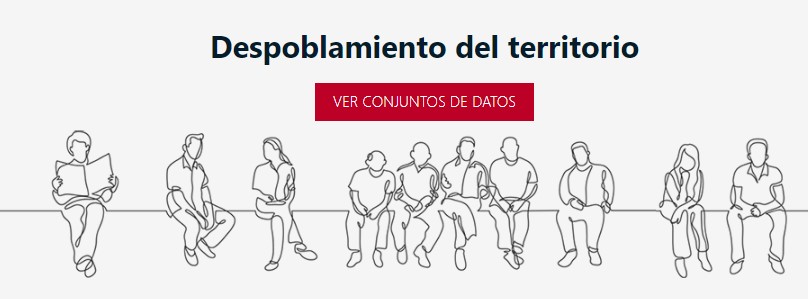
The 6 datasets included in this section on depopulation are distributed as follows:
- ATMs against depopulation, which aim to provide financial services in rural areas where it is difficult to find one.
- Electric vehicle recharging points, which aim to promote the use of electric vehicles to the detriment of more polluting conventional vehicles.
- Housing in municipalities in the province, to highlight the unequal distribution of the population between municipalities, based on geographical location within the province.
- Care centres, so that any citizen who needs them knows where to go if they require assistance.
- WiFi points in the province of Castellón, so that citizens who need it can access the Internet easily and free of charge, wherever they are.
- A list of defibrillators so that citizens can be informed of their location so that they can be called upon in the event of an emergency.
The final purpose of these 6 datasets is to make users aware of the closest services available to them, with the added intention of strengthening their presence in those areas of the province where they are currently scarce. This solution highlights the value of open data: it provides useful information to prevent regressive impacts of the population in the short and medium term, while helping to make an x-ray of the basic needs in terms of services and urgent facilities.
To generate these datasets, the Castellón Provincial Council has partnered with external institutions such as the Agència Valenciana Antidespoblament (AVANT), and with other internal departments that facilitate access to information on basic services and facilities in the towns of the interior of the province of Castellón.
In addition, for some of the datasets with geographical information, the Castellón Provincial Council has produced an interactive map. Specifically, in these six dashboards, different types of graphs and indicators are presented, which are automatically updated with the data, accompanied by a short story that facilitates their interpretation.
Data visualisations
Another of the highlights of the new data portal of the Castellón Provincial Council is the commitment to the visual content of the datasets. For each dataset, the user can generate their own graphs and maps that can be shared or embedded either through an iFrame or as a widget.
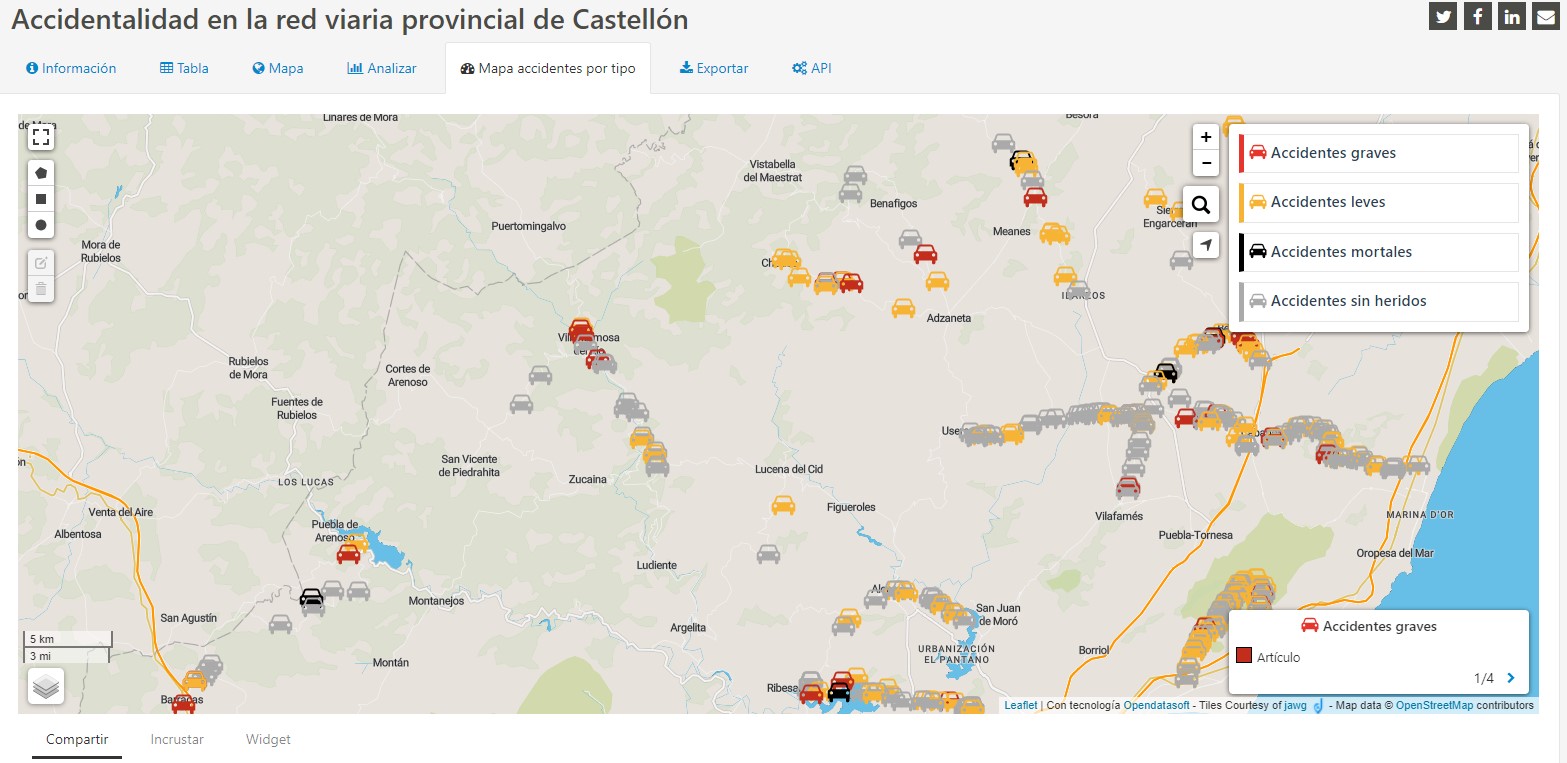
Assistance to municipalities
The government of the data portal maintains a close relationship with the Provincial Service of Assistance to Municipalities (SEPAM) in order to, in an act of openness and transparency, contribute to providing updated information on the municipalities of Castellón in terms of their political composition, territorial organisation and presence in social networks.
With this new measure, the portal aims to disseminate and facilitate knowledge of the municipalities of Castellón from the perspective of open data, and to serve as a useful and efficient mechanism for reuse.
On the other hand, it is also intended that the open data portal serves as an element of documentation, to contribute to the reliable and accurate use of the information available on the composition of the local councils and their characteristic elements: population, contact details, etc. The ultimate goal is to bring local governments closer to citizens and businesses.
Data journalism
In recent years, a new journalism specialism that uses open data to tell the news and produce stories has been gaining increasing prominence. Known as data journalism, it uses large datasets to conduct investigations and relies on digital techniques, analysis strategies and data visualisation tools to facilitate understanding of the data. Thanks to data journalism, open data portals of public administrations, agencies and institutions are becoming increasingly important as sources.
Precisely for this reason, the open data portal of the Castellón Provincial Council has designed a specific section dedicated to data journalism, accessible from the home page itself and located within the SPECIALITIES AND EXCHANGES block.

Such is the commitment of the Castellón Provincial Council to make the open data portal known to information professionals that, during the celebrations of the last Open Data Day 2022, journalists were made aware of the possibilities offered by open data. Furthermore, in order to introduce them to the use of datasets and the subsequent analysis and management required by the data, the Provincial Council itself organised a specific event with journalists and professionals from the communication sector in general.
How to expand the open data ecosystem at the provincial level?
With the aim of continuing to disseminate the potential of open data, the Castellón Provincial Council has set a series of objectives aimed at expanding the community and interest in it. These are some of the actions planned for the coming months:
- Seek integration in various international organisations to promote information sharing and good practices in the field of data.
- Continue with the design of new open data visualisations.
- Create a provincial Data Office.
- Hold activities for the promotion and dissemination of open data in partnership with other entities or through participation in commemorative events.
- Constantly review and improve the open data strategy.
In short, the work carried out by the Castellón Provincial Council through the redesign and new strategy of the open data portal highlights the value of local data for citizens and public institutions themselves. Precisely for this reason it is not surprising that more and more councils are being encouraged to open their data and generate valuable services based on it.